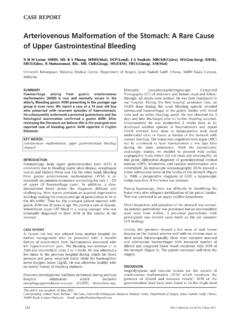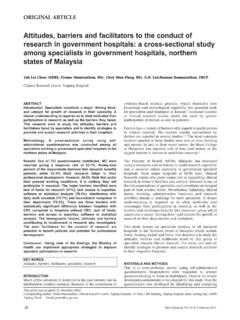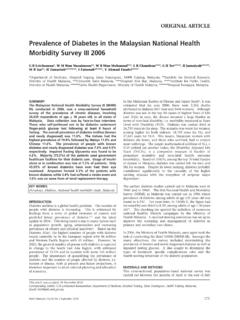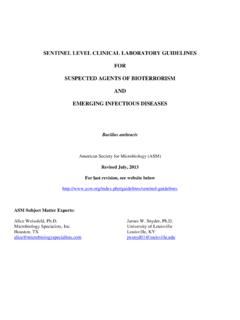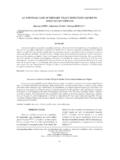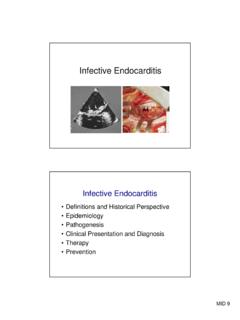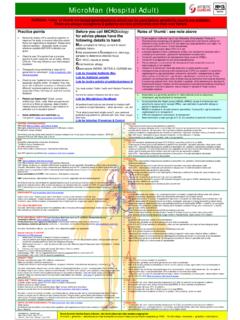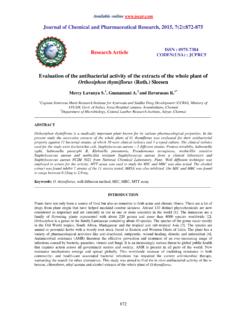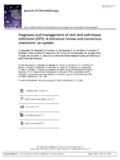Transcription of Ochrobactrum Anthropi Catheter-Related …
1 CASE REPORT. Ochrobactrum Anthropi Catheter-Related Bloodstream Infection: The First Case Report In Malaysia Siti Rohani AH, Tzar MN. UKMMC, Medical Microbiology & Immunology, Jalan Yaacob Latif, Bandar Tun Razak, Cheras, Kuala Lumpur 56000, Malaysia SUMMARY. A 60-year old Malay man presented with an intermittent low- were multiple purulent ulcers noted on his right ankle with grade fever for 3 days and worsening of right ankle ulcers. slough at the base of the ulcers. He was known to have ischaemic heart disease, diabetes mellitus type 2, hypertension and end stage renal failure and His total white cell count was with neutrophil was on regular haemodialysis. The organisms isolated from predominance ( L), suggesting a bacterial infection.
2 His the peripheral and central blood specimens were identified C-reactive protein (CRP) was also elevated. He was given as Ochrobactrum Anthropi , a rarely encountered gram- intravenous (IV) amoxycillin-clavulanic acid 12-hourly negative bacillus with a unique antibiotic susceptibility during the first 24 hours of ward admission and later was profile. His condition improved after removal of the changed to IV ampicillin-sulbactam 1g 8-hourly. Initial catheters and administration of antibiotic therapy. This case wound debridement was done during 48 hours of admission report highlights the importance of being wary of such rare, and tissue culture from the right ankle grew extended- opportunistic pathogens and good communication between spectrum beta-lactamase (ESBL)-producing Enterobacter sp.
3 The microbiologists and the clinicians. mixed with non-ESBL-producing Escherichia coli. Instead of starting a carbapenem to cover for ESBL-producing KEY WORDS: organisms, for unknown reasons, the physician decided to change the antibiotic to IV cefepime 2g 12-hourly. Ochrobactrum , Catheter-Related bloodstream infection Five days post wound debridement, the patient still had a INTRODUCTION. fever with poor glucose control, thus a below knee amputation (BKA) was performed on his right leg. He was Ochrobactrum Anthropi is a gram-negative, non-lactose- still on IV cefepime until he developed a fever with fermenting, oxidase-positive bacillus formerly known as temperature of C on day 4 post-BKA. Concurrent blood Achromobacter Centres for Disease Control and Prevention cultures were sent at this time from 3 different sites (CDC) group Vd 1.
4 It is found in hospital and environmental (peripheral vein, permcath at the right internal jugular vein, water sources and is an emerging pathogen in and from triple lumen catheter at the left femoral vein that immunocompromised patients. However so far, there has was inserted on 15th February 2012, after 4 days in situ). been no published report of Ochrobactrum Anthropi infection in Malaysia. All 3 sites of blood cultures were positive for Ochrobactrum Anthropi , identified using API 20NE (BioM rieux, France). CASE REPORT. The central line cultures were positive for more than 2 hours earlier than the peripheral vein culture, suggesting a A 60-year-old Malay man presented with an intermittent Catheter-Related bloodstream infection.
5 The antibiotic low-grade fever for 3 days and worsening of right ankle susceptibility testing showed that the isolate was sensitive to ulcers. He has a background history of ischaemic heart imipenem, meropenem, cefepime, amikacin, gentamicin, disease with small vessel disease (angioplasty done 8 years ciprofloxacin and trimetroprim-sulfamethoxazole, and ago), diabetes mellitus type 2, hypertension and end stage resistant to ceftazidime, piperacillin-tazobactam and renal failure (ESRF). He is on regular haemodialysis 3 times polymyxin-B. Intravenous imipenem 500mg with cilastatin per week done via a Permcath inserted on the right internal 500mg 12-hourly was commenced for 2 weeks and both jugular vein in February 2012. In January 2012, he was central catheters were removed.
6 Only the triple lumen admitted to orthopaedic ward at Universiti Kebangsaan catheter tip was sent for culture and the results were released Malaysia Medical Centre (UKMMC) for having right leg as mixed growth. The patient's fever settled and his general cellulitis and later was discharged with oral amoxycillin- conditions improved since then. clavulanic acid. He has been moving about on wheelchair DISCUSSION. since 6 months ago due to cerebrovascular accident. On examination, the patient had a temperature of C, Organisms formerly called CDC group Vd and heart rate of 94 beats per minute, blood pressure of 150/92 Achromobacter groups A, C, and D were renamed mmHg and respiratory rate of 18 breaths per minute. His Ochrobactrum Anthropi (from the Greek word ochros, meaning right leg appeared swollen, erythematous and tender.)
7 There pale yellow') 1. This organism is an oxidase-positive, non- This article was accepted: 24 February 2013. Corresponding Author: Tzar MN, UKMMC, Medical Microbiology & Immunology, Jalan Yaacob Latif, Bandar Tun Razak, Cheras, Kuala Lumpur 56000, Malaysia Email: Med J Malaysia Vol 68 No 3 June 2013 267. Case Report lactose-fermenting gram-negative bacillus that grows readily IV imipenem and removal of the central catheters. Since O. on MacConkey agar. It resembles the Pseudomonas species in Anthropi have different antibiotic susceptibility profiles than that it is water borne and may cause nosocomial infection. other more commonly encountered gram negative bacteria like E. Coli and Klebsiella spp., early communication is vital to Ochrobactrum Anthropi appears to be an infrequent but widely inform the clinicians regarding choice of antibiotics to distributed opportunistic pathogen; occurring in blood, switch from an empiric antibiotic to a more appropriate one respiratory tract specimens, urine, faeces, wound, ears, based on the results of antibiotic susceptibility tests.
8 Abscesses, and even on hospital and environment surfaces. In a review by Vaidya et al. 2, O. Anthropi infections have often It is also important for the microbiologists to remind the been associated with nosocomial infection in debilitated clinicians regarding the possibility of removing the central patients, most commonly catheter-associated bacteremia. catheters to aid recovery, and to send the catheter tips for Although less common, infections among immuocompetent culture to aid diagnosis. In addition, microbiologists, together individuals also occur which were associated with trauma, with clinicians should ensure that infection control measures endophthalmitis, osteomyelitis, prosthetic valves, venous are implemented and adhered to and to be wary of possible catheter, and contaminated pharmaceuticals.
9 Other risk outbreak. The IDSA has developed very comprehensive factors include previous antibiotic therapy, prior surgical guidelines 4 in the management of CRBSI and it is beyond the procedure with allografts, accidental wound, and coinfection scope of this case report to detail every aspect of the with other bacterium 3. guidelines. However in summary, the IDSA guidelines in managing CRBSI involve 4 main issues: catheter removal, The Infectious Diseases Society of America (IDSA) Clinical antibiotic therapy, antibiotic lock therapy if catheter is to be Practice Guidelines for the Diagnosis and Management of salvaged and catheter care. We strongly recommend the Intravascular Catheter-Related Infection 4 state that A readers to have a look at these guidelines.
10 Definitive diagnosis of Catheter-Related bloodstream infection CONCLUSION. (CRBSI) requires that the same organism grow from at least 1. percutaneous blood culture and from a culture of the catheter tip (A-I), or that 2 blood samples be drawn (one from a This is the first reported case in Malaysia of Catheter-Related catheter hub and the other from a peripheral vein) that, bloodstream infection caused by Ochrobactrum Anthropi in a when cultured, meet CRBSI criteria for quantitative blood patient with underlying diabetes and ESRF. Although the case cultures or differential time to positivity (DTP) (A-II). In our shows a typical presentation of the infection, it illustrates the case, the catheter tip that was sent for culture was only from importance of rapid isolate identification and susceptibility the triple lumen catheter and the results were released as testing, and prompt treatment with the right antibiotic and mixed growth.
